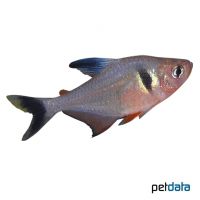Black Phantom Tetra (Hyphessobrycon megalopterus)
| Black Phantom Tetra Hyphessobrycon megalopterus | |
|---|---|
| Name | Black Phantom Tetra |
| Name Lat. | Hyphessobrycon megalopterus |
| Synonym | Megalamphodus megalopterus |
| Family | Characins |
| Family lat. | Characidae |
| Order | Characins |
| Order lat. | Characiformes |
| Origin | Brazil, Bolivia |
| Habitat | Streams, ponds |
| Diet | Carnivore |
| pH | 6.0-7.5 |
| Behavior | Peaceful |
| Keeping | Group |
| Care Level | Moderate |
| Reproduction | Egg scatterer |
| Breeding | Moderately difficult |
| Life Span | 3-5 years |
| Protection | No |
| Metric Units | |
| Size | 4 cm |
| Temperature | 20-28 °C |
| Hardness | 5-15 °dH |
| Aquarium | ~ 100 l |
| US Units | |
| Size | 1.6" |
| Temperature | 68-82 °F |
| Hardness | 89-267 ppm |
| Aquarium | ~ 25 gal |
Distribution and habitat
The Black Phantom Tetras are native to the river systems of the Pantanal (Brazil, Bolivia), the Rio Guapore and the upper Rio Paraguay. They live in slow flowing and stagnant waters as well as floodplains with dense underwater vegetation and floating plants.
Maintenance
The aquarium should have a varied, partly dense planting, with shelters and hiding places (roots) and provide sufficient swimming space. A dark substrate covered with some foliage (e.g. sea almond leaves), shaded light (floating plants) and a weak current is ideal.
No ammonia, ammonium and nitrite should be detectable, the nitrate value should not exceed 100 mg/l. To ensure the water quality and oxygen content, a filter and heater adapted to the aquarium size is required, as well as lighting for the species-appropriate day-night rhythm of the animals.
Diet
In nature they feed mainly on small insects, insect larvae and plankton. The food supply consists of live, frozen and dry food. For a balanced diet, feed once a day with a high-quality, protein-rich dry food (flakes, granules, pellets) as well as cyclops, moina, daphnia, artemia, mosquito larvae, etc. (live or frozen)
It is recommended to feed small portions several times a day. Only feed as much as will be eaten within a few minutes. A regular and varied diet promotes health and increases resistance.
Behaviour and compatibility
These very peaceful schooling fish can be kept very well with other small and peaceful fish as well as shrimp in a community tank. Males occasionally engage in harmless mock fights (comment fights). They should be kept in a group of at least 5, but preferably more fish.
In principle, only mutually compatible fish species with similar requirements for water conditions and water temperature may be socialized
Sex dimorphism
Males have smoked glass gray, jet black fins and larger dorsal fins. The females are more colorful with red adipose fin and red pectoral and anal fins.
Reproduction and breeding
They are free spawners. In soft, slightly acidic peat water they usually spawn up to 300 eggs between fine-feathered plants. The larvae hatch after 24-36 hours and swim freely after 3-4 days. The parents do not engage in brood care and should be separated from the fry after spawning, as they are spawn predators.
Fry must be fed several times a day with special rearing food (dust food, Artemia nauplii,). In community tanks breeding is hardly possible, because the spawn is easy prey.
Important
The foliage (sea almond tree, oak, etc.) enriches the water with humic substances, naturally lowers the pH and, when rotting, promotes the development of microorganisms, which are a valuable secondary food source.
The well-being of the fish should be monitored regularly. Temperature should be checked daily, pH, hardness and nitrate levels at least every 14 days. Regular partial water changes are recommended, even when contaminant levels have not yet reached the upper limit. Sudden changes in water quality should be avoided. Newly introduced fish must be accustomed slowly to the water in the aquarium.
Further literature can be found in your pet store.
References
Text: petdata; Image: petdata
Source: BMELV (1998): Tierschutzgutachten - Haltung von Zierfischen (Süßwasser); RIEHL & BAENSCH (2006): Aquarien Atlas Bd. 1, Mergus Verlag; ENGELMANN (2005): Zootierhaltung - Tiere in menschlicher Obhut: Fische, Verlag Harri Deutsch
- Gemäß § 21 Abs. 5 Tierschutzgesetz idgF
